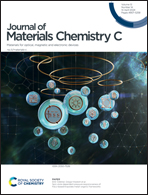Spin-state dependent pressure responsiveness of Fe(ii)-based triazolate metal–organic frameworks†
Abstract
Fe(II)-containing Metal–Organic Frameworks (MOFs) that exhibit temperature-induced spin-crossover (SCO) are candidate materials in the field of sensing, barocalorics, and data storage. Their responsiveness towards pressure is therefore of practical importance and is related to their longevity and processibility. The impact of Fe(II) spin-state on the pressure responsiveness of MOFs is yet unexplored. Here we report the synthesis of two new Fe(II)-based MOFs, i.e. Fe(cta)2 ((cta)− = 1,4,5,6-tetrahydrocyclopenta[d][1,2,3]triazolate) and Fe(mta)2 ((mta)− = methyl[1,2,3]triazolate), which are both in high-spin at room temperature. Together with the isostructural MOF Fe(ta)2 ((ta)− = [1,2,3]triazolate), which is in its low-spin state at room temperature, we apply these as model systems to show how spin-state controls their mechanical properties. As a proxy, we use their bulk modulus, which was obtained via high-pressure powder X-ray diffraction experiments. We find that an interplay of spin-state, steric effects, void fraction, and absence of available distortion modes dictates their pressure-induced structural distortions. Our results show for the first time the role of spin-state on the pressure-induced structural deformations in MOFs and bring us a step closer to estimating the effect of pressure as a stimulus on MOFs a priori.

- This article is part of the themed collection: Fundamentals and Applications of Functional Framework Materials


 Please wait while we load your content...
Please wait while we load your content...